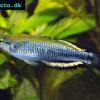Madagascar rainbowfish - Bedotia geayi
Scientific name: Bedotia geayi
Common name: Madagascar rainbowfish
Family: Bedotiidae
Usual size in fish tanks: 10 - 12 cm (3.94 - 4.72 inch)
014
Recommended pH range: 7 - 7.5
Recommended water hardness: 10 - 20°N (178.57 - 357.14ppm)
0°C 32°F30°C 86°F
Recommended temperature range: 20 - 24 °C (68 - 75.2°F)
The way how these fish reproduce: Spawning
Where the species comes from: Madagascar
Temperament to its own species: peaceful
Temperament toward other fish species: peaceful
Usual place in the tank: Middle levels
Origin
The Madagascar Rainbowfish (Bedotia geayi) is endemic to Madagascar, where it inhabits mountain streams with clean, well-oxygenated waters. These streams are often shaded by dense vegetation, creating a unique environment that the Madagascar Rainbowfish has adapted to. In captivity, replicating these conditions is key to keeping them healthy and displaying their vivid colors.
Lifespan
With proper care, the Madagascar Rainbowfish can live up to 5 years in an aquarium. Maintaining clean water, a stable environment, and a balanced diet is essential to help them reach their maximum lifespan.
Short Description
The Madagascar Rainbowfish is one of the more peaceful species of rainbowfish, making it a great addition to community aquariums. However, they can show mild aggression toward much smaller tank mates, especially in confined spaces. They are known for their beautiful silver bodies with reflective markings, which become even more vibrant under proper lighting and water conditions.
This species is best kept in groups of at least 6 to promote natural behavior and reduce stress. When kept in schools, they provide an active and colorful display in the aquarium. Due to their active nature, they require a medium to large tank with a minimum length of 90 cm (36 inches) to allow sufficient swimming space. Planting the sides and back of the aquarium with hardy plants, while leaving open space at the front, creates an ideal habitat for these fish. Additionally, they are excellent jumpers, so a tight-fitting lid is necessary to prevent them from escaping.
General Care
Madagascar Rainbowfish are hardy and can tolerate a range of water parameters, making them suitable for many aquariums. However, they thrive best in well-maintained conditions. The ideal water temperature is between 20-24°C (68-75.2°F), with a pH range of 7.0-7.5. The water hardness should be maintained between 10-20°N (178.57-357.14 ppm). It is essential to keep the water well-oxygenated by using powerheads or directing filter outlets toward the water surface to increase gas exchange.
Regular water changes of 20-30% weekly are recommended to maintain high water quality. A quality filtration system capable of handling the bioload of the tank's inhabitants is necessary, as the Madagascar Rainbowfish is sensitive to poor water conditions. Providing them with plenty of hiding spots, such as plants and decorations, will make them feel more secure, reducing stress and enhancing their colors.
Food and Feeding
The Madagascar Rainbowfish is an omnivore and will readily accept a variety of foods. Provide a balanced diet consisting of high-quality flakes or pellets as a staple. Supplement their diet with occasional treats such as live or frozen foods, including bloodworms, brine shrimp, or daphnia, to enhance their coloration and keep them healthy. They also enjoy grazing on algae, so incorporating some vegetable matter, like blanched spinach or spirulina flakes, is beneficial. Feeding them small amounts multiple times a day ensures proper nutrition and reduces the risk of overfeeding, which can impact water quality.
Sexing
Sexing Madagascar Rainbowfish can be challenging, but males are typically more colorful, exhibiting brighter hues with a more pointed first dorsal fin. Females tend to have a slightly darker, less vibrant appearance. During breeding periods, males may also display more intense coloration as part of their courtship behavior.
Breeding
Breeding Madagascar Rainbowfish in captivity can be a rewarding experience. To induce spawning, perform several small water changes over a few days to mimic their natural breeding conditions. The female will deposit her eggs on plants or fine-leaved spawning mops, and this process can continue for several months, producing a steady stream of offspring.
The eggs typically hatch after 6-7 days. Once the fry are free-swimming, they can be fed with rotifers or infusoria. As they grow, gradually introduce them to newly hatched brine shrimp and finely crushed flake food. To maximize fry survival, provide plenty of cover in the breeding tank and maintain high water quality through regular maintenance.
Conclusion
The Madagascar Rainbowfish is a peaceful and active species that adds beauty and movement to any well-maintained aquarium. With their stunning reflective scales and schooling behavior, they make an excellent choice for aquarists looking for a dynamic yet manageable fish. By providing a proper environment, stable water parameters, and a varied diet, you can ensure your Madagascar Rainbowfish thrive and display their full range of colors.

 Rainbowfish
Rainbowfish